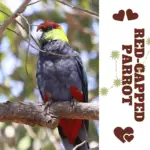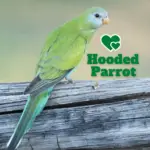
Golden-shouldered Parrot 26 cm; 54–56 g. Forehead pale yellow, mid-crown from above eye black narrowing to thin stripe down nape to mantle;
rest of head and underparts turquoise-blue but with greenwash on the face and broad red patch from belly to under tail-coverts; mantle, back, and wing-coverts mid-brown but with median coverts golden-yellow,
other outer coverts edged blue and primaries blackish edged blue; rump turquoise-blue, tail above dark greenish tinged blue, outer feathers tipped white, below pale blue tipped black.
Golden-shouldered Parrot Female pale green with pale brownish crown and pale blue on face and lower ventral region; pale underwing stripe. Immature like a female, male somewhat brighter.
Forms a species group with P. dissimilis and †P. pulcherrimus; close to former, and in the past considered conspecific. Monotypic.
Subspecies
Monotypic.
Distribution
C & S parts of Cape York Peninsula, in N Queensland (NE Australia).
Golden-shouldered Parrot Habitat
Open forest dominated by Eucalyptus and Melaleuca in the vicinity of extensive flats with terrestrial termitaria, with preference in the breeding season for woodlands adjacent to watercourses,
Golden-shouldered Parrot subsequently penetrating coastal and estuarine mangroves.
Movement
Pronounced post-breeding dispersal, with some evidence suggesting this is into coastal areas including mangroves, but probably mostly only local. Little immigration seems to occur into former areas.
Golden-shouldered parrot diet
Small grass seeds, mainly fire grass (Schizachyrium) in the dry season, supplemented by legumes, both native desmodiums and introduced Verano (Stylosanthes hamata), which are important sources of protein for nestlings;
throughout the wet season herbs, sedges, notably Scleria, and other grasses, notably Panichloa neurilemma and Alloteropsis semialata, are important.
Sounds and Vocal Behavior
In-flight gives a Platycercus-like whistled contact call. Other Golden-shouldered Parrot calls include a short up slurred “weet!” and a lower-pitched subdued “che-weh”.
Golden-shouldered parrot breeding
Apr-Jun, but second broods sometimes in Jul–Aug. Uses two types of termitaria: meridian mounds of Amitermes Laurens and conical mounds of A. scrupulous, the latter being preferred for their greater thermoregulation. Golden-shouldered Parrot Eggs 3–6; incubation lasts c. 20 days; nestling period c. 5 weeks.
Why is the golden shouldered parrot endangered
ENDANGERED. CITES I. A BirdLife “restricted-range” species.
Significant decline and contraction of range since the start of the 20th century, the species now occupying a 120 × 225 km strip in the center of the original range, and the total population at the start of the breeding season are provisionally estimated to be c. 2300 birds (including 100 ‘bachelors’),
rising to c. 3500–5000 birds at the end of the breeding period; c. 1500 held in captivity in Australia. Although commonly considered a victim of excessive trapping, the Golden-shouldered Parrot loses food resources to grazing and dry-season burning of grasslands and suffers predation by feral cats and disturbance by tourists.
The period at the start of rains is apparently critical, as a flush of new grass, renders seeds hard to access; fires at this period open up patches of the ground again, and the problem may be that there have been too few fires at the right time, owing to excessive man-caused dry-season burning.
Invasion of open grassland areas by ti-trees (Melaleuca viridiflora), which is reducing appropriate habitat for the parrots by about 5% per decade, is also a consequence of the altered fire regime.




















